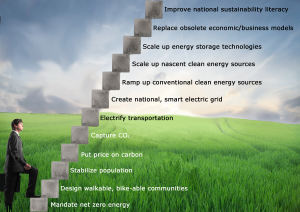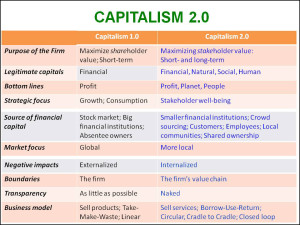A 12-Step Program for Our Fossil Fuel Dependency
PwC released its Low Carbon Economy Index 2013 last week. It confirms that we will reach the tipping point for climate destabilization by 2034 unless we end our fossil fuel addiction. And, in an interview with Alternet last month, Rob Hopkins, founder of the Transition Network, said: “It feels like the world has gone from ‘there’s no problem’ to saying ‘it’s too late,’ without the bit in the middle: ‘maybe we can actually do something.’” This blog is about the bit the middle. It lays out a 12-step program that will transition us to a clean energy economy if we are serious and smart about how we stage the steps during the transition.
These findings reinforce the stark choice that I laid out in my last blog: Stranded Assets or Stranded Humanity – Choose One. But if we choose not to bring fossil fuel reserves to market, what is our plan to wean ourselves off our addiction to oil and gas while protecting our quality of life?
Here are the 12 steps.
Demand-side programs
The first six steps reduce our need for fossil fuel energy, without a reduction in our quality of life.
1. Mandate net zero energy (NZE) residential and commercial buildings. California has already done this. Buildings use 70% of our electricity, consume 40% of our energy, and generate 40% of our national greenhouse gases. We already know how to construct NZE buildings and how to retrofit buildings to that same standard. Mandate it.
2. Design walkable, bikeable communities
Reduce the need for private cars in order to access groceries, shops, work, schools, and recreation.
3. Stabilize the population
One of the biggest drivers of energy demand is the exponential rise of human population—the “population bomb.” More people; more energy demand. Flatten the population growth curve by making birth control universally available; educating young women; providing better family planning; giving equal status to women in society; providing safe, legal access to abortions; and making the right to die with dignity safe and legal.
4. Put a price on carbon
A price on carbon sends a motivational pricing signal to encourage moving away from fossil fuels. Introduce a revenue-neutral carbon tax to discourage fossil fuel use and to fund infrastructure and energy technology transitions suggested below. Ideally, level the playing field with a global carbon tax. Help disadvantaged people through the transition.
5. Capture CO2
The problem isn’t fossil fuels, per se; the problem is the CO2 emitted when they are burned. Oceans absorb about a third of our CO2 emissions, but they are becoming acidified. Require large installations that still use fossil fuels to capture and sequester emissions using vegetation, algae, biochar, capture-and-storage reservoirs, or other carbon sponges.
6. Electrify transportation
In the U.S.A., about 70% of petroleum is used for transportation. Mandate electric cars and trucks to remove that demand. Electrify trains and mass transit systems. Promote virtual travel and meetings to reduce business flights.
Supply-side programs
The next four steps reduce our need for fossil fuels by substituting non-fossil fuels as our sources of energy.
7. Create a national, smart electric grid
If we electrify everything, we need a national smart grid to gather and distribute electricity from diverse, decentralized clean energy sources. Match supply with demand on a national scale, and possibly on an international scale. Include a national network of charging stations for vehicles; make quick-charging stations as ubiquitous as today’s gas stations.
8. Ramp up conventional clean energy sources
In the U.S.A., a surprising 67% of generated electricity is lost in transmission. To reduce transmission distances, aggressively deploy community-owned, household-owned, and local company-owned wind and solar installations. Supplement them with commercially-owned gigantic off-shore wind farms, and on-shore wind farms in remote locations with good wind regimes. Exploit run-of-the-river hydroelectricity, concentrated solar power, passive solar energy, geothermal energy, and biomass energy sources.
9. Scale up nascent clean energy sources
There are several exciting cleantech energy sources that are not yet ready for prime time: wave power; tidal power; space-based solar power (SBSP); ocean thermal energy conversion (OTEC);and maybe even fusion power. Scale them up.
10. Scale up energy storage technologies
The Achilles heel of wind and solar power is that they are intermittent. Provide grid-scale storage of surplus green energy until it is needed. Move from prototype to large-scale deployment of pumped hydro storage; grid-scale compressed air storage; gigantic battery banks; and molten salt storage.
System-level programs
For this to happen quickly enough to avoid the impending climate destabilization tipping point, we need to address two systemic factors.
11. Replace obsolete economic and business models
Creatively destruct today’s outdated Capitalism 1.0 system and replace it with a more fit-for-the-future Capitalism 2.0, which accounts for the value of natural capital. Change the scorecards used in the game of business to give credit for environmental and social responsibility, and to better assess the risk of large carbon footprints in the company’s value chain.
12. Improve national sustainability literacy
Replace the economically-myopic and misleading GDP with a Genuine Progress Indicator (GPI) that acknowledges social and environmental dimensions of our wellbeing. The education value of this single move would be enormous. It would awaken businesses and citizens to what really counts and promote acceptance of necessary behavior changes. It would help us see how we could have a better quality of life with less consumption. Build pervasive sustainability mindsets by integrating environmental and social concepts into our primary, secondary, and post-secondary education systems. Help people understand how the real world works, the importance of protecting the carrying capacity of the planet, and how dangerously close we are to exceeding planetary boundaries on issues like climate change.
Imagine if we had to accomplish this transition in the next 15 years, which we do. Imagine if oil and gas companies redesigned their business models to be energy companies, and used their economic and political clout to accelerate this 12-step plan. Imagine if citizens demanded that governments provide the required policy, subsidy, and regulatory support.
This could work, but only if we start now. Let’s not squander this window of opportunity.
Please feel free to add your comments and questions using the Comment link below. For email subscribers, please click here to visit my site and provide feedback.
Bob






Comments are closed.